The Goddesses of Judaism
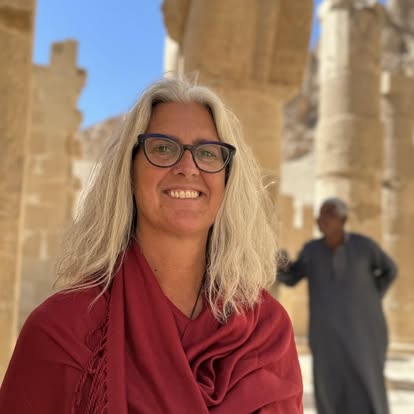
Most of us are oblivious to the existence that the Hebrew people worshipped a goddess for thousands of years. Shrines to this goddess began on hilltops and were part of the fabric of the Temple of Jerusalem. This knowledge was either carefully redacted (edited) out of the Bible or misunderstood by translators, her existence lost.
I explored a Hebrew settlement in a most unlike place – Egypt! On a tour with Kathleen McGowan, we began in Aswan and visited Elephantine Island, near Aswan far up the Nile, where an ancient and isolated Hebrew colony began around 600 BCE.

On Elephantine Island there is evidence of pre-Torah beliefs and goddess-worship retained by the Hebrew Elephantine community. The discovery of documents written in Aramaic around 500 BCE are evidence of a Jewish community and a temple on the island. A legend states that the Ark of the Covenant was once hidden here. This Hebrew community in Egypt traced its origins to Bethel, not Jerusalem.
There was a second bride of Yah at Elephantine, whose name was Bethel.Karel van der Toorn in ‘Becoming Diaspora Jews: Behind the Story of Elephantine’ tells us the Elephantine community originated in the mid-seventh or mid-sixth centuries BCE. Following destruction of Jerusalem and Solomon’s Temple in 586 BCE , Judean refugees travelled to Egypt to settle in Alexandria and south to Elephantine.
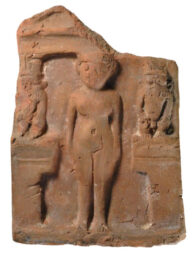
This statue names her as Anath, Lady of Heaven, Mistress of the Gods! In Dynasty 21 the statues and doorways were reused in a temple in the new capital city of Tanis. What I find most exciting is the goddess-worship that was been documented here. This terracotta plaque is an Egyptian image of a Judaen goddess of the Elephantine Jews. She is sometimes shown with a small boy at her side indicating there was an associated savior figure but no written myth explains that possibility, other than Torah’s promise of the coming of Emmanuel (Isaiah 7:14).
The other exciting thing about this community is that it does not seem to have any knowledge of a written Torah or its narratives. The Elephantine papyri demonstrate that monotheism and the Torah could not have been established in Jewish culture before 400 BCE, and that the Torah was therefore likely written in the Hellenistic period, in the third or fourth centuries BCE.
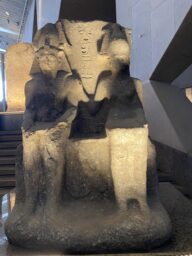
This is my photo of a granite statue of Anath with Ramesses II in the Grand Egytian Museum (GEM 6748) from the New Kingdom, Nineteenth Dynasty, about 1279 – 1213 BCE, from the Precinct of Anath, Tanis (San el-Hagar). Anath was a war goddess from Ugarit (modern Syria). According to the Grand Egyptian Museum in Cairo, Ramesses Il introduced her into Egypt as a wife of the god Seth. He built a temple to her at Piramesse in the Delta, with inscribed doorways and at least two pair-statues of the pharaoh and goddess.
Arthur Cowley in ‘Aramaic Papyri of the Fifth Century B.C.’ states: “So far as we learn from these texts Moses might never have existed, there might have been no bondage in Egypt, no exodus, no monarchy, no prophets. There is no mention of other tribes and no claim to any heritage in the land of Judah. Among the numerous names of colonists, Abraham, Jacob, Joseph, Moses, Samuel, David, so common in later times, never occur (nor in Nehemiah), nor any other name derived from their past history as recorded in the Pentateuch and early literature. It is almost incredible, but it is true.”
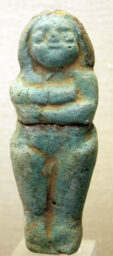
Excavation work done in 1967 revealed the remains of the Jewish colony centred on a small temple. The earliest account of the Hebrew temple is from 525 BCE with altars for incense offerings and animal sacrifices. They maintained their own temple (the House of Yahweh) alongside the Temple of Khnum. The temple may have been built in reaction to Manasseh’s reinstitution of pagan worship or simply to serve the needs of the Jewish community.
At Elephantine the Hebrew people continued to worship two brides of Yahweh – Anat-Yahu (Yahweh’s Anath) and Anath-bethel (Anath is the House of the God of Heaven), later shortened to Bethel with beth-ulah, virgin. This tiny figurine was found amongst the ruins of the Egyptian Satet temple on Elephantine Island.
The original Bethel cult was an earlier purer form of primitive Iron Age Judaism. Anat-Yahu was observed as the bride of the Hebrew God at Bethel and Shiloh long before the Jerusalem Temple.
Anat-Yahu was yet another name for Anath (see my blog: The Goddesses of Canaan) who was closely associated with Ishtar/Astarte and may be the same goddess or different. Anat-Yahu is similar to Yo-Elat in Ugaritic texts (which might mean Yahweh’s Elath) as a name of Asherah. Egyptians altered her name considerably to Neith.
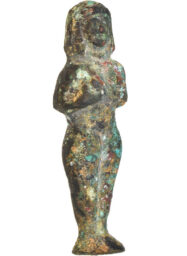
This figurine was found in Israel, an image of Anath from the First Temple period. Anat-Yahu was worshipped in primitive Judaism as the bride of the Hebrew God, especially in Bethel and throughout the territory of Benjamin. Her shrine within the Yahweh temple precincts in Bethel has been investigated by archaeologists.
In a fifth century BCE papyri Anat-Yahu is worshipped in the temple to Yahweh originally built by Jewish refugees from the Babylonian conquest of Judah. The texts were written by a group of Jews living at Elephantine, practicing an ancient religion of the Hebrew people.
The papyri describe the Hebrew community worshipping Anat-Yahu who is described as either the wife or paredra (sacred consort) of Yahweh or as an aspect of Yahweh. This is echoed in the Ugarit temple of Baal Gebal which holds a female half of Baal usually known as Anat, called in one Ugarit text “the beloved sister of Baal who with him celebrates the sacred marriage”.
Due to the seclusion of Elephantine Island, the Anat-Yahu cult continued an ancient faith, where the colony thrived uninterrupted from before the Babylonian exile (c.586 BCE) until after the fall of the Jerusalem Temple. K.L. Noll in ‘Canaan and Israel in Antiquity: An Introduction’ described the religion in the Elephantine Hebrew community as “nearly identical to Iron Age II Judahite religion”.
The papyri describe the Jews as worshiping Anat-Yahu (Anat-Yahweh). Anat-Yahu (mentioned in document AP 44, line 3, in Cowley’s numbering) is described as either the wife (or paredra, sacred consort) of Yahweh or as a hypostatized aspect of Yahweh.
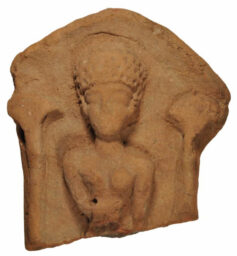
This terracotta plaque of Anat-Yahu was found on Elephantine Island (modern Aswan) in Egypt, now in the British Museum. A fifth century BCE papyri mentions a goddess called Anat-Yahu worshipped in the temple to the Hebrew God originally built by Jewish refugees from the Babylonian conquest of Judah. Anath continued to be worshipped by the Hebrew people in the island-city of Elephantine well after the fall of the Jerusalem Temple.
Anath, like other Semitic goddesses, was often shown beside or astride a lioness or pair of lionesses. This is the appearance of the goddess of the Hebrew people who survives to this day in the form of the Sabbath Bride and as Malkhut, the Lower Shekhinah (female presence of the Hebrew God).
Asherah
An interesting passage describes another Hebrew community in Egypt around 600 BCE. The colony were goddess-worshippers alongside their Hebrew God. The prophet Jeremiah was in the Egyptian city of Tahpanhes, delivering a message to the Jewish exiles who have fled there after the destruction of Jerusalem, harshly condemning their continued idol worship and defiance against God’s commands even in their new location.
Jeremiah (c.626-587 BCE) refers to the goddess religion as being brought to Egypt from Jerusalem long ago. The passage hints that the religion was followed by women, although Jeremiah tries hard to obscure this and emphasise the authority of their husbands.
“Then all the men who knew that their wives were burning incense to other gods, along with all the women who were present—a large assembly—and all the people living in Lower and Upper Egypt, said to Jeremiah, ‘We will not listen to the message you have spoken to us in the name of the Lord! We will certainly do everything we said we would: We will burn incense to the Queen of Heaven and will pour out drink offerings to her just as we and our ancestors, our kings and our officials did in the towns of Judah and in the streets of Jerusalem. At that time, we had plenty of food and were well off and suffered no harm. But ever since we stopped burning incense to the Queen of Heaven and pouring out drink offerings to her, we have had nothing and have been perishing by sword and famine.’ The women added, ‘When we burned incense to the Queen of Heaven and poured out drink offerings to her, did not our husbands know that we were making cakes impressed with her image and pouring out drink offerings to her?’” (Jeremiah 44:15-19).
The Queen of Heaven for the Hebrew people was Asherah who was a goddess of Canaan (see my blog: The Goddesses of Canaan). After the Hebrew people settled in the highlands of Canaan, they adopted many of the urban customs of their Canaanite neighbours, borrowing heavily in architecture, technology, literature and even poetry.

By 1500 BCE the written records show a shift towards the god El over the goddess Asherah as his consort. As monotheism took hold, Asherah became the consort and wife of the Hebrew God. Inscriptions found at the archaeological sites of Kuntillat Arjud and Khurbet el-Qom inscriptions dating from the first millennium BCE read “Yahweh’s Asherah” who sits at his “right hand” – the throne of power, reserved for the queen or queen mother who grants sovereignty to the king.
At Kuntillat Arjud in the northern Sinai on the border of Judah, the site is scattered with dedicatory inscriptions to “YHWH and his ASHERAH”. One stands out in particular: “To YHWH of SHOMRON and his ASHERAH” (Meshel 2012: 86–101). Shomron or Samaria was the capital of Israel, very far from this peripheral border of Judah. Along with the inscription, the drawings found with the inscriptions match the iconography found on the shrines, for instance the Tree of Life, with volutes and lotus blossoms for branches, feeding caprids, and a lion standing underneath this tree of life.
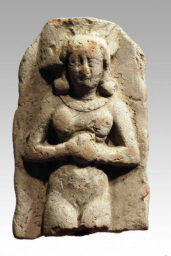
Asherah, meaning Holy Queen, was Anath’s mother, was also worshipped by the Hebrew people . A figurine recovered from Beth-shaan, in modern day Israel, of a Goddess with the head of a lioness, or a priestess wearing a lioness mask, probably represents Asherah. In Jerusalem, lion-headed Asherah was the goddess of tunnel diggers and probably of all construction, when she was addressed as Baalah. This clay bas relief is of Asherah, dated around 999-600 BCE.
The Torah, the first five books of the Jewish Tanakh, ultimately became the Old Testament of the Christian Bible. Asherah is used forty times in the Torah, often in conjunction with Ba’al. In both the Torah and the texts from Semitic-speaking Ugarit, Asherah, often symbolised by a tree, was the goddess representing fertility, endowing life and prosperity to her followers.
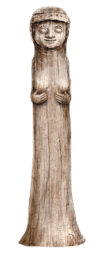
This meant that representations of the goddess could be an image of a woman called Asherah or a tree trunk or standing stones (plural is masseboth or masseba in the singular) or baetyl all called asherah. Asherah was also represented with a pair of poles known as asherim, or natural trees and groves, rather than sculptured images. The more abstract asherah representations are the most ancient. Hypothetical Asherah pole imagined by artist Marcos Telas of Santiago, Chile.
The Torah describes wooden stylised trees, poles or actual trees known as asherahs standing next to hilltop shrines along with the stele and altars. Abraham built an altar at the oak of Moreh where God had appeared to him (Genesis 12:6) and later planted a tamarisk tree in Beer-sheba where he called upon the name of God (Genesis 21:33).
There were no capital letters in Hebrew so this makes it difficult to tell whether the Torah writers meant asherah the pole or Asherah the goddess. When the Torah was first translated no one knew the meaning of the word asherah.

This is a terra-cotta Ta’anach cult stand from the tenth century BCE now in Israel Museum. The word asherah was associated with sacred places and trees, so when the Torah was translated into Greek for the first time between the third and first centuries BCE, the Greek translators of the Septuagint were unfamiliar with the word asherim and so translated it as grove. Translating asherim as grove carried into the Latin Vulgate at about 400 CE and into the King James Bible, published in 1611.
The writers presumed that the groves were evidence of an ancient obsession with trees, especially as they were usually mentioned in the Torah with commands to stop venerating them. It made no sense. The confusion between asherahs, asherim, a feminine noun that appears sometimes referring to an object, often in plural and sometimes as a name and Asherah the Canaanite goddess, confounded early translators of the Bible.
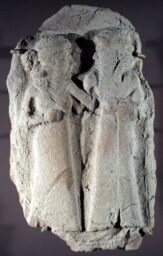
Worship of Asherah and Ba’al were reviled for the incense-burning practices in the Bible. The priests and priestesses of Asherah and her son Bal Baal were known as prophets. The priests of Asherah and Ba’al were also known as highly gifted in dream interpretation and prophecy. This relief is actually an Amorite plaque depicting Ašratum and Amarru, but I imagine similar existed of Asherah and Ba’al.
In ‘The Return of the Divine Sophia: Healing the Earth through the Lost Wisdom Teachings of Jesus, Isis and Mary Magdalene’ Tricia McCannon notes that as Mother of Wisdom, Asherah temples were renowned oracular centres with priest-and-priestess diviners capable of prophesying the future. Asherah means She Who Builds. Priests and priestesses taught carpentry, brick making and building techniques in her sacred groves.
This irritated the prophets of the Hebrew God. The Hebrew prophets attempted to make laws against the practices in the Canaanite temples, and the interpretation of dreams.
This led to the threats to their lives by the followers of the Hebrew God: “If a prophet, or one who foretells by dreams, appears among you and announces to you a sign or wonder, and if the sign or wonder spoken of takes place, and the prophet says, “Let us follow other gods” (gods you have not known) “and let us worship them,” … That prophet or dreamer must be put to death for inciting rebellion against the Lord your God, who brought you out of Egypt and redeemed you from the land of slavery. That prophet or dreamer tried to turn you from the way the Lord your God commanded you to follow. You must purge the evil from among you.” (Deuteronomy 13:1-2,5).
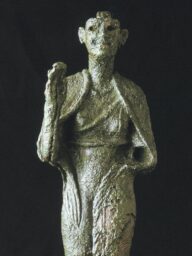
This statue could be the All-Mother Asherah or Anath. It was found near the town of Ugarit, dating to around 1400-1300 BCE.
Throughout the Torah, the kings and their prophets are destroying the asherah or replanting them. Some kings worshipped the goddess in the hilltop shrines (King Solomon, Rehoboam, Abijam), while others reviled the goddess and destroyed asherah poles (King Ahab, Ahaz, Hezekiah, Josiah) and others replanted and maintained them (King Asa, Manasseh).
Incredibly, long after the Hebrew people were told not to, they continued the old traditions, worshipping asherahs to gain comfort in the divine input in nature. The continuous attacks, as recorded in the Old Testament, no doubt destroyed much precious and irretrievable information of goddess-worship.
The Babylonian Exile proved to be the end of the Asherah cult. By the time the Hebrews returned after 70 years of exile, the goddess and her priestesses were under attack.
The Deuteronomists attempted to erase all trace of the divine feminine face of god. Asherah began as a powerful mother goddess, then became wife of Yahweh and finally was rejected completely.
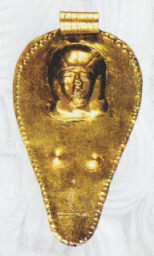
The Levite priests used indirect methods that are easy for a modern reader to miss. Rather than attack the goddess, they misrepresented her, misspelling and mispronouncing her name as boseth meaning shame, referring to her in the masculine, and not recognising her position or authority by constantly referring to her as the consort of Ba’al.
Eventually the goddess was replaced with the Hebrew God. Just like all the other gods and goddesses of the Hebrew pantheon, Asherah was demoted, ridiculed, openly criticised and destroyed.
This is possibly Asherah as a pendant from Ugarit, shaped like a vagina for a fertility amulet, but also shaped like an oil lamp because Asherah brings light to the world. At the bottom of the amulet is a sapling in a triangular pot. The triangle is a vulva symbol.
By the Hasmonean dynasty the last traces of public goddess worship ended with forced conversions at sword point in Galilee and outlying provinces around 160 BCE.
In the Gospel of James (also called Protoevangelium of James, written around 145 CE), the birth of Jesus also alluded to Asherah worship. When Mary goes into labour, Joseph goes to find a midwife: “and leaving his two sons beside her, he went out to seek a midwife in the district of Bethlehem”. Joseph notes the midwife he chose was “coming down from the hill-country”. Joseph reported having to leave two sons behind to go for a midwife.
Then there’s where the midwife was coming from. The “hill-country” signified the sacred places of Asherah. Asherah worship occurred outside in the country “on every high hill and under every green tree,” a recurring phrase throughout Kings in relation to the Asherah cult throughout Israel.
The priests are seeking a verdict from Asherah whether Joseph and Mary are sinners. Joseph does not find any old midwife, but a midwife returning from a hilltop shrine, and possibly a priestess or devotee of Asherah. The Gospel of James makes many startling claims.
When Joseph had met the midwife he identified who was giving birth: “It is Mary that was reared in the temple of the Lord, and I obtained her by lot as my wife. And yet she is not my wife, but has conceived of the Holy Spirit” (Gospel of James 19). This gives us exciting evidence of accepted goddess worship in Judaism.
There is also tantilizing evidence in the Holy Qurʾān, written between 595–855 CE, that hilltop shrines to Asherah were still being used in Jesus’ time. There is a fascinating account of Jesus’ birth that describes Mary, mother of Jesus (in Arabic Miriam or Maryam), going to a hilltop shrine and using a palm tree to assist her to give birth and give her sustenance:
“And she conceived him, and she withdrew with him [in her womb] to a remote place (makānañ qaṣiyyā). And the pangs of childbirth drove her unto the trunk of the palm tree (nakhlah). She said: ‘O, would that I had died here thus and had become a thing of naught, forgotten!’ Then (one) cried unto her from beneath her, saying: “Your Lord has placed a spring beneath you, And shake the trunk of the palm tree toward you, you will cause ripe dates to fall upon you. So, eat and drink and be consoled (literally meaning to cool your eyes). And if you meet any mortal, say: ‘Lo! I have vowed a fast unto the Merciful, and may not speak this day to any mortal’.” (Qurʾān Sūra 19:22-26)
Mary was described giving birth under a palm tree, a symbol of Asherah. In ‘On the Mystical Shape of the Godhead’ Gershom Scholem stated that the Aramaic word atiq can mean both ancient and removed, so that Mary’s withdrawal to a remote place (“she secluded herself away”; “she withdrew to a distant place” sūra 19:17) may subtly allude to the ancient or eternal aspect of her celestial counterpart that she is an earthly manifestation of (Arabic tajallī, Mandaic dmuta). Dates were important to the Prophet Mohammed. According to his wife Aisha, the Prophet applied dates in an almost sacramental manner to new-born infants.
In ‘The Secret Adam’ Lady E.W.S. Drower described that Mohammed “used to chew dates and with them he would anoint the mouths of the Companion’s children when they were born.” Muslims apparently still feed new-born infants date paste. Was this tradition a re-enactment of the scene of Jesus’ birth at the date palm?
Which place and period in her-story resonates for you?
Which goddess draws your curiosity?
Examples of Jewish goddesses: Anath, Asherah, Astoreth, Astarte
